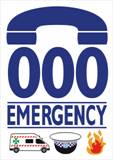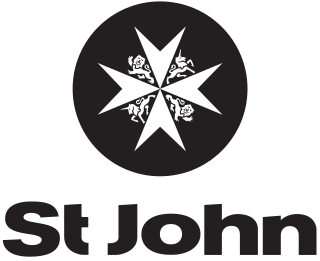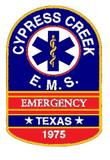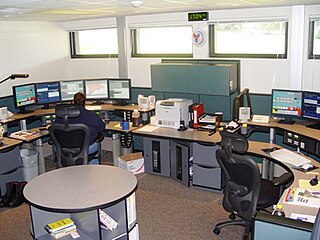Related Research Articles

Emergency medical services (EMS), also known as ambulance services or paramedic services, are emergency services which treat illnesses and injuries that require an urgent medical response, providing out-of-hospital treatment and transport to definitive care. They may also be known as a first aid squad, FAST squad, emergency squad, rescue squad, ambulance squad, ambulance corps, life squad or by other initialisms such as EMAS or EMARS.

Audrain County is a county located in the central part of the U.S. state of Missouri. As of 2010, the population was 25,529. Its county seat is Mexico. The county was organized December 13, 1836, and named for Colonel James Hunter Audrain of the War of 1812 and who later was elected to the state legislature.

9-1-1, also written 911, is an emergency telephone number for the North American Numbering Plan (NANP), one of eight N11 codes. Like other emergency numbers around the world, this number is intended for use in emergency circumstances only, and using it for any other purpose is a crime in most jurisdictions.

An emergency is a situation that poses an immediate risk to health, life, property, or environment. Most emergencies require urgent intervention to prevent a worsening of the situation, although in some situations, mitigation may not be possible and agencies may only be able to offer palliative care for the aftermath.
Enhanced 911, E-911 or E911 is a system used in North America to automatically provide the caller's location to 911 dispatchers. 911 is the universal emergency telephone number in the region. In the European Union, a similar system exists known as E112 and known as eCall when called by a vehicle.

Most public switched telephone networks have a single emergency telephone number that allows a caller to contact local emergency services for assistance. The emergency number differs from country to country; it is typically a three-digit number so that it can be easily remembered and dialed quickly. Some countries have a different emergency number for each of the different emergency services; these often differ only by the last digit.
Dispatchers are communications personnel responsible for receiving and transmitting pure and reliable messages, tracking vehicles and equipment, and recording other important information. A number of organizations, including police and fire departments, emergency medical services, motorcycle couriers, taxicab providers, trucking companies, railroads, and public utility companies, use dispatchers to relay information and coordinate their operations. Essentially, the dispatcher is the "conductor" of the force, and is responsible for the direction of all units within it.

000 is the primary national emergency number in Australia. The Emergency Call Service is operated by Telstra and overseen by the Australian Communications and Media Authority, and is intended only for use in life-threatening or time-critical emergencies. Other emergency numbers in Australia are 112 for GSM mobile and satellite phones, which is answered by a 000 operator and 106 for TDD textphones. 000 was also the emergency number in Denmark and Finland until the introduction of the 112 number in 1993 and in Norway until 1986, when the emergency numbers diverted to 001 for fire brigade, 002 for police and 003 for ambulance. Those numbers changed in 1994 to 110, 112 and 113 respectively.

The British Columbia Ambulance Service (BCAS) is the sole ambulance service and provider of pre-hospital emergency care in the province of British Columbia. BCAS is managed by British Columbia Emergency Health Services (BCEHS) and falls under the jurisdiction of the Provincial Health Services Authority (PHSA). The service is tasked with the provision of emergency medical response province-wide. Today, BC Ambulance is among the largest Emergency Medical Services (EMS) provider in Canada and North America. The fleet consists of more than 500 ground ambulances operating from 183 stations across the province along with 80 support vehicles. BCAS provides inter-facility patient transfer services in circumstances where a patient needs to be moved between health care facilities for treatment. BCAS also operates an airevac program that utilizes both fixed-wing and rotary aircraft.

Hamilton Paramedic Service is the designated service provider for emergency medical services (ambulance) in the City of Hamilton, Ontario.

St John New Zealand is a charitable organisation providing healthcare services to the New Zealand public. The organisation provides ambulance services throughout New Zealand, and also plays an increasing role in meeting the broader health needs of New Zealand communities through a number of health services and products.
Winnipeg Fire Paramedic Service (WFPS) provides Fire and EMS services to the City of Winnipeg, Manitoba. It operates from 27 Fire stations, 2 stand-alone Ambulance stations, and 3 administration offices across the city. WFPS has two equally important divisions: The Winnipeg Fire Department (WFD) and Winnipeg Emergency Medical Services (WEMS), using a centralized dispatch system.
Emergency Medical Service in Germany is a service of public pre-hospital emergency healthcare, including ambulance service, provided by individual German cities and counties. It is primarily financed by the German health insurance companies.

Cypress Creek Emergency Medical Services (CCEMS) is an emergency medical service provider in North Harris County, within greater Houston, Texas. All ambulances in use by CCEMS are Mobile Intensive Care Units (MICU), with at least one Paramedic, making all ambulances ALS units. CCEMS has a service area of approximately 177 square miles (460 km2) and has 13 stations plus 2 Peak-hour ambulances, a communication center that dispatches both fire and ambulance, and an education center.
Grady EMS is an emergency care provider owned by Grady Healthcare System.

The Medical Priority Dispatch System (MPDS), sometimes referred to as the Advanced Medical Priority Dispatch System (AMPDS) is a unified system used to dispatch appropriate aid to medical emergencies including systematized caller interrogation and pre-arrival instructions. Priority Dispatch Corporation is licensed to design and publish MPDS and its various products, with research supported by the International Academy of Emergency Medical Dispatch (IAEMD). Priority Dispatch Corporation, in conjunction with the International Academies of Emergency Dispatch, have also produced similar systems for Police and Fire
Emergency medical services in Australia are provided by state ambulance services, which are a division of each state or territorial government, and by St John Ambulance in both Western Australia and the Northern Territory.

An emergency medical dispatcher is a professional telecommunicator, tasked with the gathering of information related to medical emergencies, the provision of assistance and instructions by voice, prior to the arrival of emergency medical services (EMS), and the dispatching and support of EMS resources responding to an emergency call. The term "emergency medical dispatcher" is also a certification level and a professional designation, certified through the Association of Public-Safety Communications Officials-International (APSCOI), the National Academies of Emergency Dispatch, and PowerPhone, Inc. Many dispatchers, whether certified or not, will dispatch using a standard Emergency Medical Dispatch protocol.

Emergency Medical Service in Austria is a service of public pre-hospital emergency healthcare, including ambulance service, provided by individual Austrian municipalities, cities and counties. It is primarily financed by the Austrian health insurance companies.
The tapping protocol is an initiative developed by the City of New York to provide members of the deaf and hard of hearing community, as well as others who are unable to voice, with a means of directly reporting emergencies to 9-1-1 from the streets of New York City.
References
- ↑ Caughron, Chele. "Priority System relays emergency instructions before ambulance arrives". Sun-Sentinel; Fort Lauderdale, Florida. Archived from the original on 2002-02-11. Retrieved 2010-09-05.
- ↑ Culley, Linda L.; Henwood, Daniel K.; Clark, Jill J.; Eisenberg, Mickey S.; Horton, Christy (1994). "Increasing the efficiency of emergency medical services by using criteria based dispatch". Annals of Emergency Medicine. 24 (5): 867–872. doi:10.1016/S0196-0644(54)00223-5. PMID 7978559.
- ↑ "Emergency Medical Dispatching" (PDF). National Association of Emergency Medical System Physicians. Archived from the original (PDF) on 2008-05-12. Retrieved 2010-09-06.
- ↑ Petricca, Michael G. "The Politics of Emergency Medical Dispatch". NENANEWS (National Emergency Number Association News/The 9-1-1 Association). Archived from the original on 2002-02-08. Retrieved 2010-09-05.